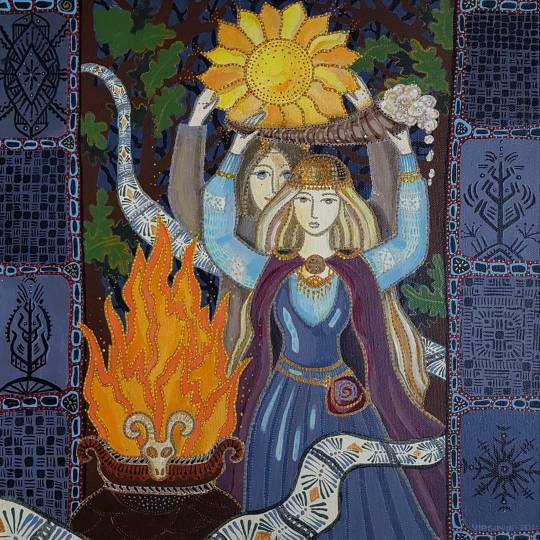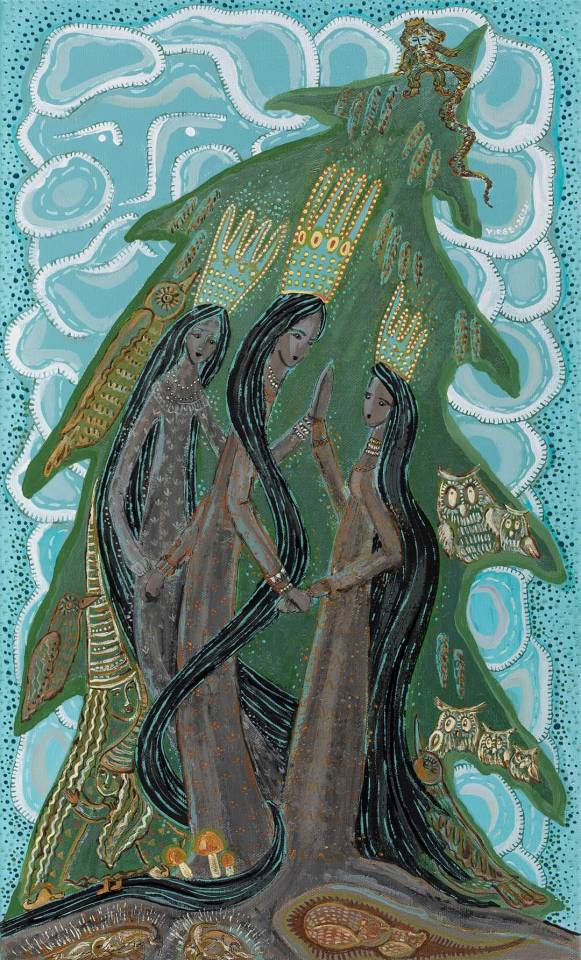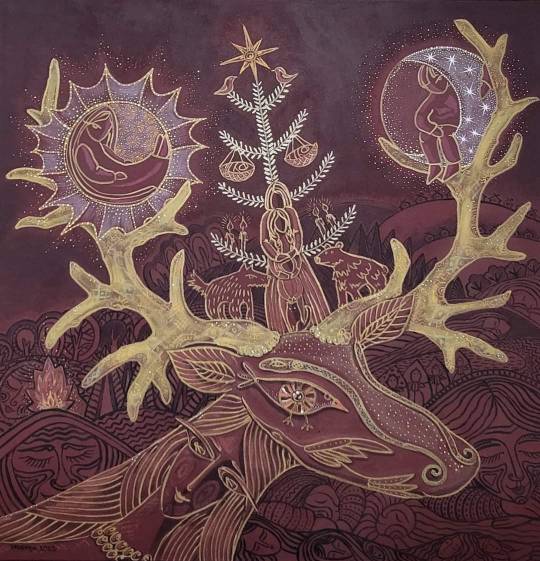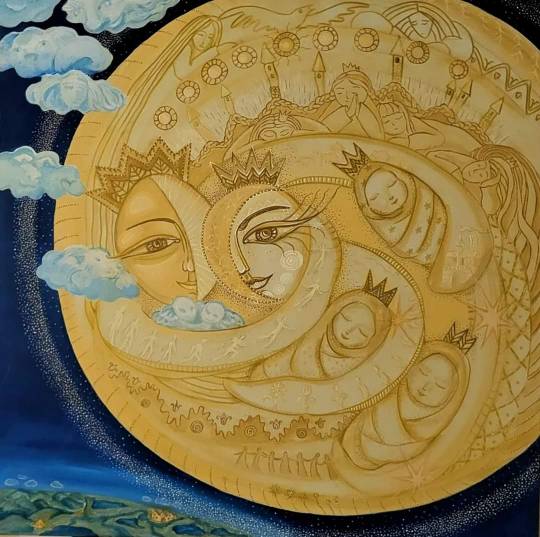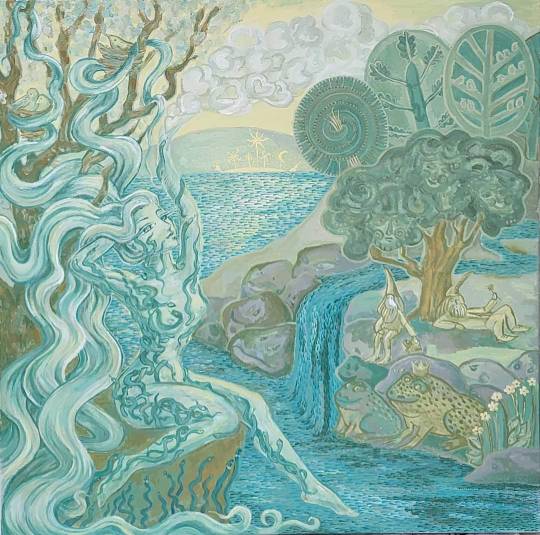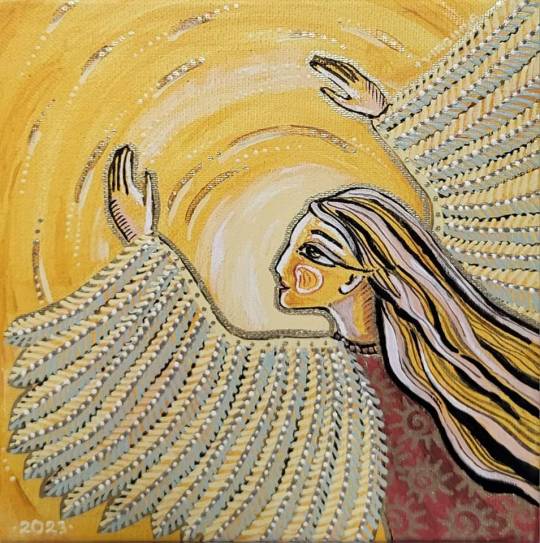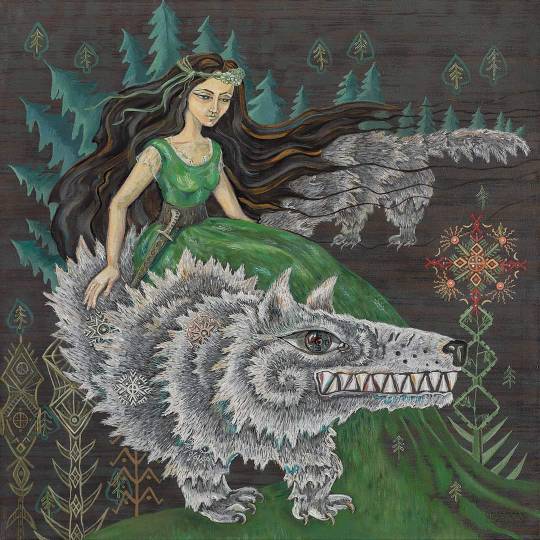Be kind to nature :)South-African | Lithuanian | Paganism nerd | Agnostic/athiest
Don't wanna be here? Send us removal request.
Note
Hello! I've taken a peek at the witch craft book library you've put together, but I'm a bit confused how it works. I can't find books it says have been uploaded and I was wondering if you could help me figure out what I'm doing wrong. Thank you for uploading such a large amount of readings in one place ♡
I completely forgot to update here! So due to the large amount, (and I refuse to give google my money for storage) I've been moving them to MEGA. I'm still slowly moving things over from the Google Drive, it's a work in progress and I haven't had much time lately. If you can't find what you are looking for then please don't hesitate to ask. ☺ I'll update the Masterlist to include the MEGA link as well so it's easier to fine. ☺
Thanks everyone for being patient while things get moved around!
MEGA Library:
https://mega.nz/folder/gWM2VLqQ#WJogJj3_w3ysb0RxoX-igQ
Library Masterlist:
https://docs.google.com/spreadsheets/d/1-NC7wToVh0_hpNbuvhBEI2BUdWPbkpLlM2G15P76tiA/edit?usp=drivesdk
(Still Cleaning Out) Google Drive:
https://drive.google.com/drive/folders/10mkrjBylnr59A6lWrJQ7R7SNgbZTu8d4
42 notes
·
View notes
Text
the celebration of Žolinė in Lithuania
Yesterday on August 15 was Žolinė, so here's a little infodump about it (minus the church-related traditions, I'm not as familiar with them).


Žolinė, otherwise known as Assumption of Mary, is a national holiday in Lithuania. It is observed as a Catholic celebration today, however, I will focus on its non-Christian related traditions which characterise it as a celebration of the harvest, to which gratitude and generosity were central.
Although the beliefs of Baltic Paganism were constantly shifting, unorganised region-to-region and not very well recorded, we can claim that the goddess of Earth and plants Žemyna (or perhaps her possible predecessor Lada) played a major role in this holiday before Catholicism made its way into the mainstream, or at least borrowed elements from a separate holiday which was for her.

Ethnologist Gražina Kadžytė points out some of the key motifs for this celebration in folk polyphonic chants, such as the ritual importance of feasts due to plentitude of food after a successful harvest, the flourishing of nature as well as its connection to afterlife (it is important to note that according to folklore the spirits of the dead accompany Lithuanians to major holidays or even everyday as birds or, more commonly, bees).
The meaning of the word Žolinė (roughly 'grass holiday') betrays one of its traditions that has been incorporated with Christianity, that being the blessing of wildflowers and field grasses, along with vegetables and grain in some regions.


Some other traditions include brewing beer and baking bread from the fresh harvest, young women making 9 wreaths out of different plants which would then be used for incense, medicinal tea or additions to other wreaths, such as the one made after building a house. It was also important to create elaborate grasses’ bouquets, a case could be made for them being depictions of the tree of life as both share the same name of Jievaras, signifying the diversity of the universe through the variety of flora used.
But that is it from me! I definitely don't know every single thing, so you are welcome to add.
59 notes
·
View notes
Text
I want to make information on Lithuanian folklore in English more public so I am uploading the threads that until now were only on my Twitter. I present to you a comprehensive thread on aitvarai, the ancient Lithuanian deities of the skies

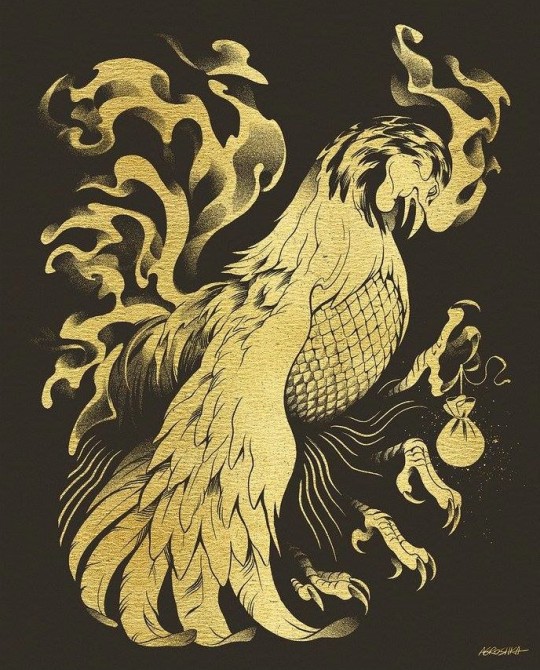
(art credits: Neringa Meškauskaitė, Agroshka )
Aitvarai (etymologically "ones to appease" or "irrepressible force") are domestic creatures associated with all 4 elements: a comet of fire which harnesses wind for chaos, helping Earth and its people while being chased and punished by Perkūnas for stealing water.
Most commonly a black rooster, they can appear as a variety of creatures: different kinds of black birds, grass snakes, whirlwinds, comets and even men if they fall in love with a woman that they want to marry.
Though very powerful ancient beings, Aitvarai choose to associate themselves with people, with villagers being able to either hatch them from an egg of a 7 year old rooster or attract them by leaving out hot, untouched meals like porridge and scrambled eggs.
When part of a household, the duties of an aitvaras were to bring riches to his caretakers, either as money (money carrying aitvarai were golden, deep red or silver in coloration) or as wheat (grey and black colors). Note that aitvarai only served the poor, tricking the wealthy people who tried to use them.
Aitvarai were both a blessing and a curse: while they did bring wealth, they did it by stealing from the neighbors of their master, making them most hated in the local village. They were also clingy and dangerous to keep, burning down the houses of those who mishandled them by feeding them manure, tampering with their meals or disobeying the rules they set for the person.
It is said however that their thieving, evil nature was a characteristic given to them by the Catholic church, which wanted to demonize every pagan creature in Baltic mythology.
In fact, aitvarai were considered genuine problems by those who believed that they would steal from them: from warding off statuettes in granaries to court cases from 1700's accusing people of harboring an aitvaras (I found only one source claiming this, so take it with a grain of salt).
However, the desire to have an aitvaras was apparent as well, shown by modifications peasants would make to their homes: holes in the doors of granaries would be made so an aitvaras could enter the home easily.
Some rituals for stealing back from a flying aitvaras exist as well, ranging from simply showing it your bottom, to cutting oneself with a rusty knife, pinning the corner of your jacket to the ground, ripping or otherwise ruining clothing.
Even if the reaction of people to them was mixed, aitvarai were considered pests by the gods due to their tendency to drink/hoard water, for which they were struck dead by Perkūnas, exploding into sparks that caused forest fires, the thunder god's lightning forming ponds, holes and swamps, terraforming the earth.
176 notes
·
View notes
Text
If you’re ever having a breakdown, just remember the wise words of the lord himself

7K notes
·
View notes
Text
When I say "connect with nature" I don't just mean the aesthetic forests with deer and beautiful flowers.
I mean the weeds growing through concrete, the fungus that grows on the rotten shed, the nettles that always seem to return and the scary, spindly cellar spider in the corner of the bathroom.
Nature is not always pretty or magical - the pigeons and seagulls you swat at are nature too, the wasps and flies that hover by your meals are animals too, store-bought strawberries and the leaves that fall from your neighbour's tree are not all that different from the Giant Sequoias and it's seeds.
If you want to connect and understand nature, I mean *really* connect to it, in it's entirety, you have to seek out and learn about the ugly, scary and mundane things as well. You don't have to like it, just don't forget that it's there.
16K notes
·
View notes
Text
PSA for new Pagans❗️🚩🚩🚩
(Overlooked pagan holidays)


Paganism isn't a singular religion,
it is an umbrella term for thousands of different pre-christian polytheistic faiths that span Antiquity. Heathenry (Norse polytheism) Mesopotamian, Phonecian, Hellenic Polytheism, Kemeticism/Netjerism, Slavic Polytheism, Celtic, Roman, Basque, etc. It goes on and on. Sometimes, these religions are even combined or synchronized, like Greco-Egyptian polytheism.
So, no, not all pagans celebrate Yule, or Beltane, or whatever.
Yule itself seems to be more of a Wiccan (new age) revival than a continued tradition.
There are quite literally thousands of holidays and traditions celebrated that no one talks about because people, especially newer converts, seem to believe paganism is its own singular religion.
So, here are some of my favorite holidays I celebrate that aren't usually talked about:

The Anthesteria:
A 3 day drunken celebration in honor of Dionysus and the Dead. Houses would be decorated with spring flowers, ghosts swept from the home; feasting and drinking no matter your status, and offerings given to the Dead and the Furies so that may not harm you, as they were said to roam the earth at this time.
Tar/pitch was also spread onto doorframes and black hellebore was hung to protect the home.
It was held each year from the 11th to the 13th of the month of Anthesterion, around the time of the first full moon of the year.
The Haloea:
The closest Greek equivalent of "Yule" celebrating the winter solstice and which honored Demeter, the goddess of agriculture, crops, fertility, and harvest.
During the festival, people would celebrate by preparing a rich meal with dough cakes in the shape of genitalia, telling lusty jokes and swearing with vulgarity, singing, drinking, and dancing.
The festival took place in Athens and ended in Eleusis during the month of Poseideon, which is December.
The Dionysia:
where plays originated! Comedy, tragedy, and drama.
The Festival of Dionysus, otherwise known as the “Greater Dionysia” took place in the spring (around our March) when playwrights would compete to entertain Athenian citizens,
complete with parades of giant phalluses and sacrifices of bulls!
The Feat of Sekhmet:
an annual festival at the beginning of the year, which began around August for the Egyptians following Wep Ronpet, or the New Year.
The festival was a time of drunkeness with red beer and wine, where Egyptians would dance, play music.
The goal was to imitate the drunkenness that had once stopped the goddess Sekhmet from destroying humanity.
According to Egyptian mythology, Sekhmet became so bloodthirsty from humanity betraying her father Ra, that she nearly destroyed all humans on Earth. The other deities asked Ra to stop her, and he eventually pacified her by making her believe the wine or beer was blood and she drank herself to sleep, turning into either Hathor or Bastet.
the Aphrodisia:
The festival of Aphrodite! The festival occurred during the month of Hekatombaion, which modern scholars recognize as starting from the third week in July to the third week of August.
the first ritual of the festival would be to purify the temple with the blood from a dove, the sacred bird of Aphrodite. Afterwards, worshipers would carry sacred images of the goddess, as well as Peitho, in a procession to be washed.
During the festival it was not permitted to make bloody sacrifices, since the altar could not be polluted with the blood of the sacrifice victims, which were usually white male goats.
This of course excludes the blood of the sacred dove, made at the beginning of the ritual to purify the altar. In addition to live male goats, worshipers would offer fire, flowers, and incense.
This was even celebrated in Thebes, Egypt, where Aphrodite had a large cult following.
Wep Ronpet:
Wep Ronpet is the Kemetic New Year.
It falls usually somewhere btwn late July and mid-August. The date for Wep Ronpet varies each year, as it is marked by the rising of Sopdet, modernly known as Sirius. Wep Ronpet is in fact one day long.
However, there are 5 days of excitement leading up to Wep Ronpet that we typically call the Epagomenal Days, or the Intercalary Days.
The Epag. days came about from a myth where Nut got pregnant with 5 kids. Ra got upset about this and forbade her from giving birth on any day of the year. Thoth, being the tricky guy that he is played a game of Senet with the moon, and upon winning this game of Senet, he received a small portion of the moon which he used to create an extra 5 days which she can use to birth her five children.
Traditionally, these days are said to be a little weird because they are ‘outside of the norm’. Usually great care was taken not to take too many risks.
So, each day is dedicated to the god that was born on that particular day. The order that it goes in is:
Osiris
Heru-wer (Horus the Elder)
Set
Aset
Nebhet (Nephthys)
Normally, celebrations of Wep Ronpet include prayers to Sekhmet against the 7 arrow or plagues of the year: libations and offerings to the Netjeru, song, dance, feast.
Ritual bathing for purification is sometimes done afterwards.
Personally, I like to perform execration, banishing all the illness, negativity and harm from the previous and coming year.
207 notes
·
View notes
Text
I pray to thee, Lady Hestia, Blessed Keeper of Hearth and Home,
Protector of families both by blood and by choice,
You who maintain the eternal fire on Olympus,
You are the spark that ignites the flame,
The warmth that comforts in the chill of night.
In your unending warmth and tender-heartedness,
My soul finds peace and healing.
Please guide me with patience and strength as I strive for independence,
And navigate the complexities of life
May your divine presence bring harmony within my family and protection for my home.
With profound gratitude and unwavering reverence,
I offer this prayer to you,
O Hestia, eternal and benevolent.
May your favor be ever upon me.

354 notes
·
View notes
Text
May Lord Apollon always give light to you in your darkest moments.
May Lady Artemis assist you in forging your own path - the one least traveled.
May Lord Ares plant your feet on the ground and keep you steady.
May Lady Athena remind you of the power you wield to turn the tide in your favor.
May Lady Aphrodite smile back at you in your own reflection as a reminder of your worth.
May Lord Hephaestus encourage you to look back with pride at your own strength and resilience.
May Lord Hermes guide your steps when they're filled with uncertainty.
May Lady Persephone emphasize all of the beauty that exists in the world around you that has gone unnoticed.
May Lord Dionysus nurse your passion for life, celebrating even the smallest things with you.
May Lord Poseidon aid you in knowing when to assert yourself and when to go with the flow.
May Lady Hestia warm you on your coldest nights and shelter you from every storm.
May Lady Demeter keep your plate full and your cup overflowing.
May Lady Hera show you how to keep your head held high, even when the world heckles you.
May Lord Zeus raise your strengths and talents higher to prove to you how amazing you truly are.
May Lord Haides sit with you on days of worry and offer a grounding hand to hold.
2K notes
·
View notes
Text
altars for greek gods
this post includes hades, persephone, artemis, apollo, aphrodite, hermes, and hekate. for part 2 including zeus, hera, poseidon, hestia, hephaestus, dionysus, ares, demeter, and athena click here, for nyx click here.
keep in mind that typical offerings to any god includes meat, wine, grain (specifically barley), honey, and incense (myrrh and frankincense would be period appropriate), but i'm listing some specific offerings that can be given if you'd like
colors can be used for candles, banners, decor, whatever you want

HADES
Colors: black, red, and white for association with death. purple and metallics for association with riches/wealth
Offerings: mint, asphodel, white poplar, pomegranate, coffee, cinnamon, elm, money, chocolate
Crystals: gemstones, black crystals (obsidian, black tourmaline, smokey quartz, etc.), pyrite, hematite, labradorite
Animals: black ram, owl, serpent, Cerberus
PERSEPHONE
Colors: purple, pink, yellow, green for association with springtime. black and metallics for association with Hades. white for purity.
Offerings: pomegranate, flowers, grains, asphodel, lavender, rosemary
Crystals: amethyst, gemstones, moss/tree agate, milk quartz, jade, lepidolite
Animals: deer, ram, bat, talking birds (including parrots)
APHRODITE
Colors: red and pink for love/sexuality. white and blue for association with the ocean. gold for association with, well, gold.
Offerings: roses, chocolate, shells, myrrh, gold
Crystals: rose quartz, pearl, emerald, opal, aquamarine, rhodonite, rhodochrosite, ocean jasper, morganite
Animals: swan, dove, hare
ARTEMIS
Colors: white, blue, black, and grey for association with the heavens. brown and green for association with nature/the hunt.
Offerings: moon shaped foods, frankincense, cypress, mugwort, amaranth
Crystals: morganite, moonstone, aventurine, selenite, celestite, moss/tree agate, amethyst, quartz (specific dendritic), labradorite
Animals: deer, wolf, wild boar
APOLLO
Colors: yellow, white, and blue for association with the heavens. red, orange, and pink for healing. purple and green for the Oracle
Offerings: sun shaped foods, bay leaves, laurel, cypress, playing music, poetry
Crystals: sunstone, amber, calcite (specifically honey and yellow), quartz (specifically rutilated or clear), rose quartz
Animals: cow, snake, hawk, crow/raven, cicada, swan
HERMES
Colors: green and gold for money/luck. white and brown for travels.
Offerings: money, crocus/saffron, strawberries
Crystals: jade, malachite, fluorite, pyrite, lapis lazuli, citrine, alexandrite
Animals: tortoise, ram
HEKATE
Colors: purple, blue, and green for magic. red and black for association with underworld
Offerings: garlic, saffron, crossroad dirt, black salt, ashes, sage, cedar, yew
Crystals: labradorite, obsidian, hematite, black tourmaline, amethyst, bloodstone, serpentine, lepidolite
Animals: wolf, boar, serpent, lion, horse, cow
5K notes
·
View notes
Text
To those of you who worship obscure divinities: there are no rule that bind you except your own. Go worship that obscure deity. Go invent that festival from scratch. Go make that offering even if it’s unusual. Go write that prayer even if you’re the only one who gets it. Go play around with your freedom as a practitioner and explore! Even in a spiritual context, creativity is a gift.
2K notes
·
View notes
Text
whenever i get sad that i don’t have friends to worship and do rituals with, I remember that birds sing love songs into the sky everyday, and the grass dances in the wind when it blows. And the clouds blush at the sunset, and the wind whistles tunes, and the bees hum, and the deer trot. And then I remember that the river runs, and the flowers open themselves to the sun, and the bugs sleep on warm leaves. and as I walk and pray, perhaps the rabbits nibbling on shrubs are praying too, perhaps that’s why the spider spun her web so beautifully. and then I remember that I’m not worshipping alone. I never was.
4K notes
·
View notes
Text
So I've been spending the last few monthes reading, watching, walking, and just overall researching foraging safely and the types of plants in my area. Today was the first day with my spouse and son that I was able to identify some plants confidently... so of course with my direction we began foraging.


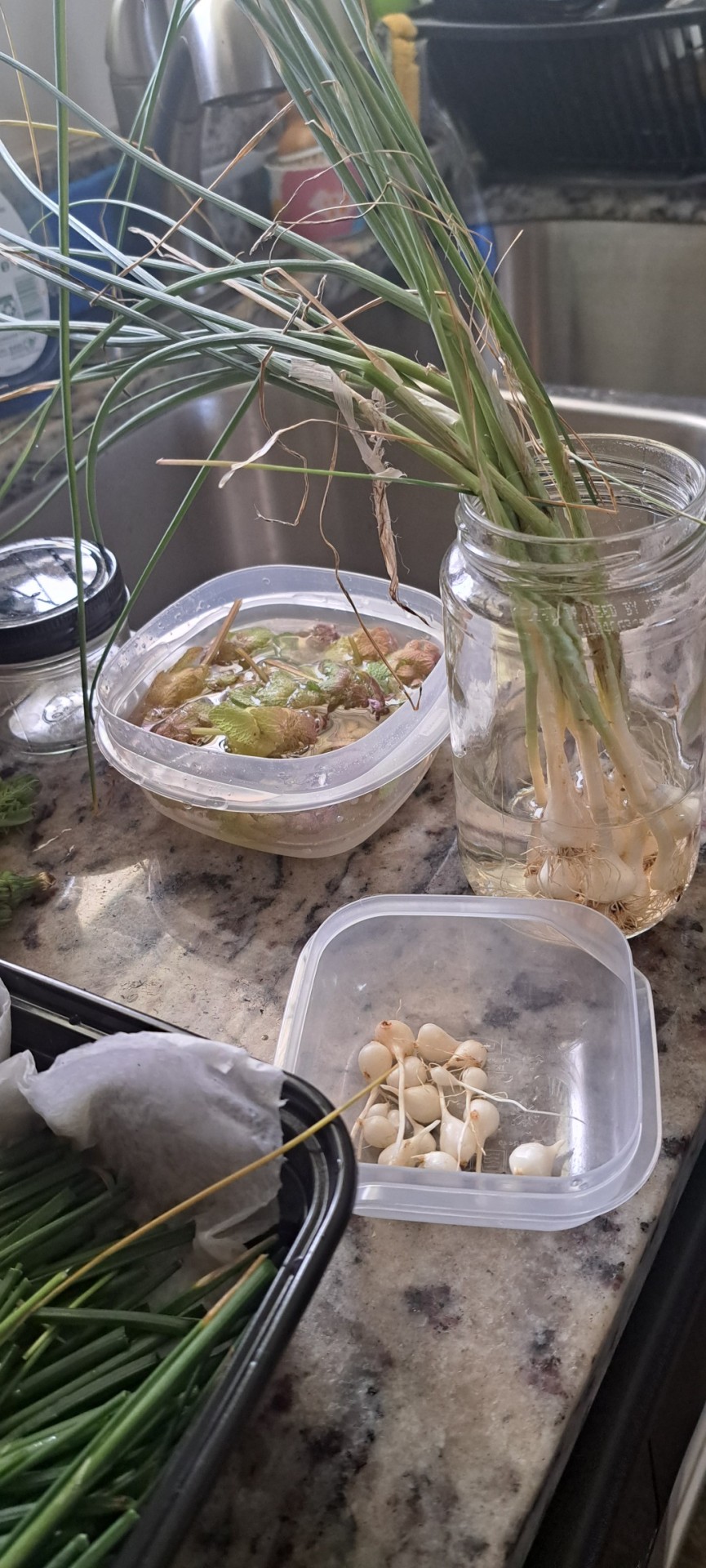
It saddens me that one of the main motivators for foraging today is knowing that my neighbors and my mother in law would be getting their lawns mowed soon and most of what I gathered today would've been lost. People just don't know what they have.
We pay to remove plants, herbs and even fruits growing naturally in our lawns, only to go buy the same plants from our grocery stores.
Plants found:
Dandelion: the whole plant is edible if you can spot it from its copycat. The leaves can be used the same way as most greens, it's roots when dried can be used to brew Dandelion coffee, and the flowers can be used for tea and to make honey
Chives and Onions: a common herb and garnish its stalks grow back once cut. If left to grow long enough they absorb nutrients better and can produce bigger onions but for now these chives were found before being mowed over and the onions are quite small but very strong and flavorful
Dead nettle: this one was new to me learning about it near the end of winter and seeing the small purple flowers growing. The flowers and leaves droop downward almost making a closed umbrella shape. It can be eaten raw or cooked and is used in salads and smoothies for garnish and flavor. They are high in nutrients and vitamins. Left to grow in the sun the purple turns almost pinkish and the leaves get lighter but still useful
Pine (cones, needles and seeds): I didn't forage the cones or needles today cause I knew I'd be busy, but baby pinecones can be cooked and eaten and the needles when cleaned and placed into an airtight container with water and sugar make a soda. I managed to find a few seeds in some of the fallen cones and saved them to plants in our future home
That's what we foraged. We are waiting for some more plants to develop and managed to convince my mother in law to leave certain sections of the lawn left uncut as some plants are still just starting back. Plants were waiting on are plantains, honeysuckle, and violets. Some plants are still too early to identify.
Using the dandelion greens tonight and making a pesto with some of them combined with the dead nettle and onions to use for a future pasta.
690 notes
·
View notes
Text
1K notes
·
View notes
Text
every day wake up & remind yourself you are an animal
16K notes
·
View notes
Text
just learned that magnolias are so old that they’re pollinated by beetles because they existed before bees
390K notes
·
View notes
